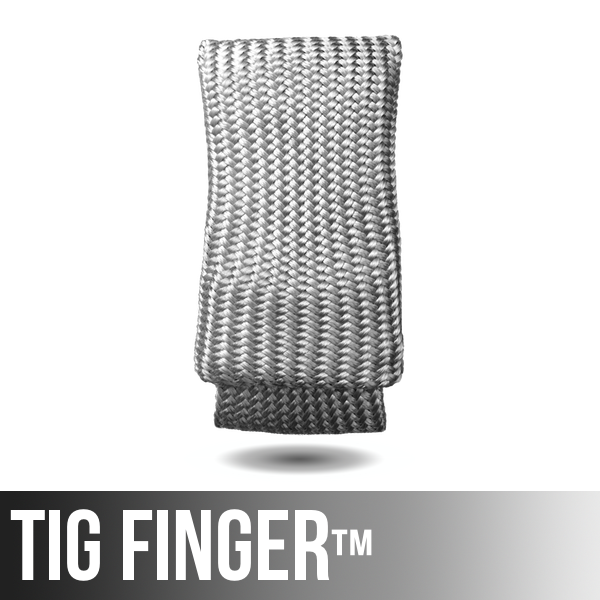Video Transcript
Tig Welding Bead Restarts
Today, we’re talking about TIG welding restarts. You’re welding along and you have to stop for whatever reason, and you have to start again. That’s a restart, and you’d like to be able to make your restarts in such a way that you can’t really tell. So if you have to stop five times even in a six-inch run, it looks pretty much like there is one continuous bead. That’s the goal anyway, and that’s what we’re going to be talking about today. I’m going to try to show some real up close shots of the restart and describe what’s going on so that you’ll have a method in your mind on making consistent restarts. Also, I’m going to talk about something called the three-second rule. Let’s get into it.
What I have here is a piece of six-inch long 11-gauge cold rolled steel, that’s roughly an eighth of an inch thick, or 125,000s thick, 3.2 millimeters thick. I’m using one-sixteenth, 1.6 diameter filler metal. And I talked about that three-second rule. That means I want to get a puddle established and get moving within three seconds. We’ll talk about it a little bit more as we go.
I’m also trying to pull that top toe, that filler metal all the way up to the corner to make this a full filler weld. I’m trying not to leave any little chewed off areas there. Well, I’ll stop here in a minute, taper off. I’ll only take about a second or two to taper off because with mild steel, it’s just not crack sensitive. You don’t have to taper off very slow. Other materials that are crack sensitive you do have to taper off a lot slower.
There the crater. That’s what we’re going to restart and I’m going to view that as if it was a target and a bullseye sort of. So I’m going to aim at the center of it with my arc. I’m going to light up on the center of that thing with a nice, fresh, sharp electrode, and I’m going to try to get that puddle grown within three seconds and get moving.
I’m going to give you a real closeup look at that. We’re going to take a look at it and examine it. Light up, one, two, three, and in move, and go. And that’s really all there is to it. Here’s a slow motion, light up in the center of the puddle. Increase the puddle by pressing the foot paddle until the puddle matches the previous size and then move and dab just like you’re resuming your travel speed.
We’ll take several more looks at this because I’m going to stop about five times on this little six-inch run. Just like always, good practice is a nice tight arc length. Keep this hot tip of that rod shielded with the argon gas and things will go a lot better.
So there’s another stop. Stop. Let the post-flow do its thing for at least, probably five to eight seconds on carbon steel, probably a little longer on stainless steel. A lot less on aluminum. You don’t have to worry about it on aluminum. Here we are again doing the same thing over again.
I’m using a little gas lens. It’s called a stubby gas lens kit. It’s on a 17 air-cooled torch. At the very end of this video, I’ll give a little one minute commercial on that thing but I’ll save it to the end. You can see it’s doing a pretty good job of keeping that bead fairly shiny.
All right, here we go again. Light up right in the bullseye, grow the puddle to where it was before and then continue on. And it doesn’t matter if it’s a lap joint, a butt joint, a T joint, same thing applies. Now, with stainless steel, you probably want to get the thing going within two seconds or less. Stainless steel heat builds up and then you can’t outrun it. But with carbon steel, a three-second rule seems to work out pretty well. Aluminum might take a little bit longer due to the thermo-conductivity of it but you get the point.
One more time, light up in the middle, press the peddle down, get the puddle to match the crater and then move on. I thought it was one more time but I guess we’re going to do it once again. Repetition is the way to practice and learn.
Sometimes getting a lot of different looks at something is beneficial too when you’re trying to learn a little certain welding technique. This should about wrap it up. This will take it all the way out to the end. And normally, you would never stop five times. You probably wouldn’t stop five times on a little six-inch run like this but sometimes you just have to stop and it’s great to be able to make a decent restart.
Okay, like I said, we’re going to have a little commercial here talking a little bit more about the Stubby Gas Lens. Here we go. Standard style cups that come with TIG torches work okay until you need to extend the electrode out very far at all, like anything past three-eighth of an inch and you’re kind of questionable.
Here I’ve got it extended out seven-sixteenth of an inch with 20 CFH and a number six cup and you can see, it’s just not doing well. The stainless is getting oxidized. It’s not flowing like it should. It’s a ropy bead. It’s not what you want to see on a stainless steel weld. You want to see that thing shiny.
All right, I’m going to extend this electrode out a little bit further on a seventeen torch. This is a Stubby Gas Lens Kit with the same CFH of argon flow and the puddle is just flowing a lot better. When you’re free from oxidation, the puddle flows nicer. It takes less heat to flow the puddle. It looks nicer.
The Stubby Gas Lens Kit comes with one-sixteenth, 332 and one-eighth hardware along with some electrodes, and not only will it give you better shielding and let you extend your electrode out, it shrinks the overall size of the torch to let you reach tighter areas.







Leave a Reply